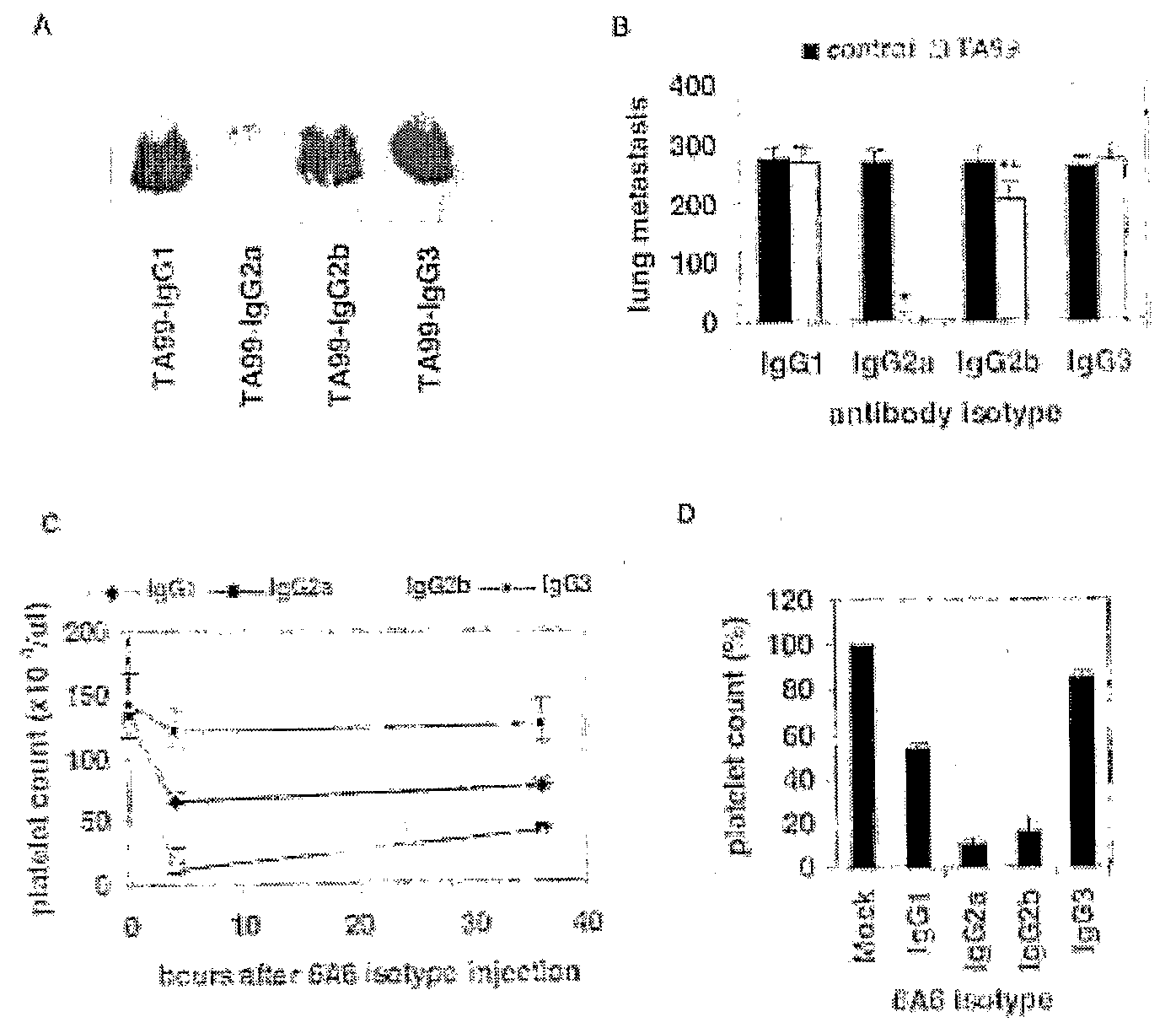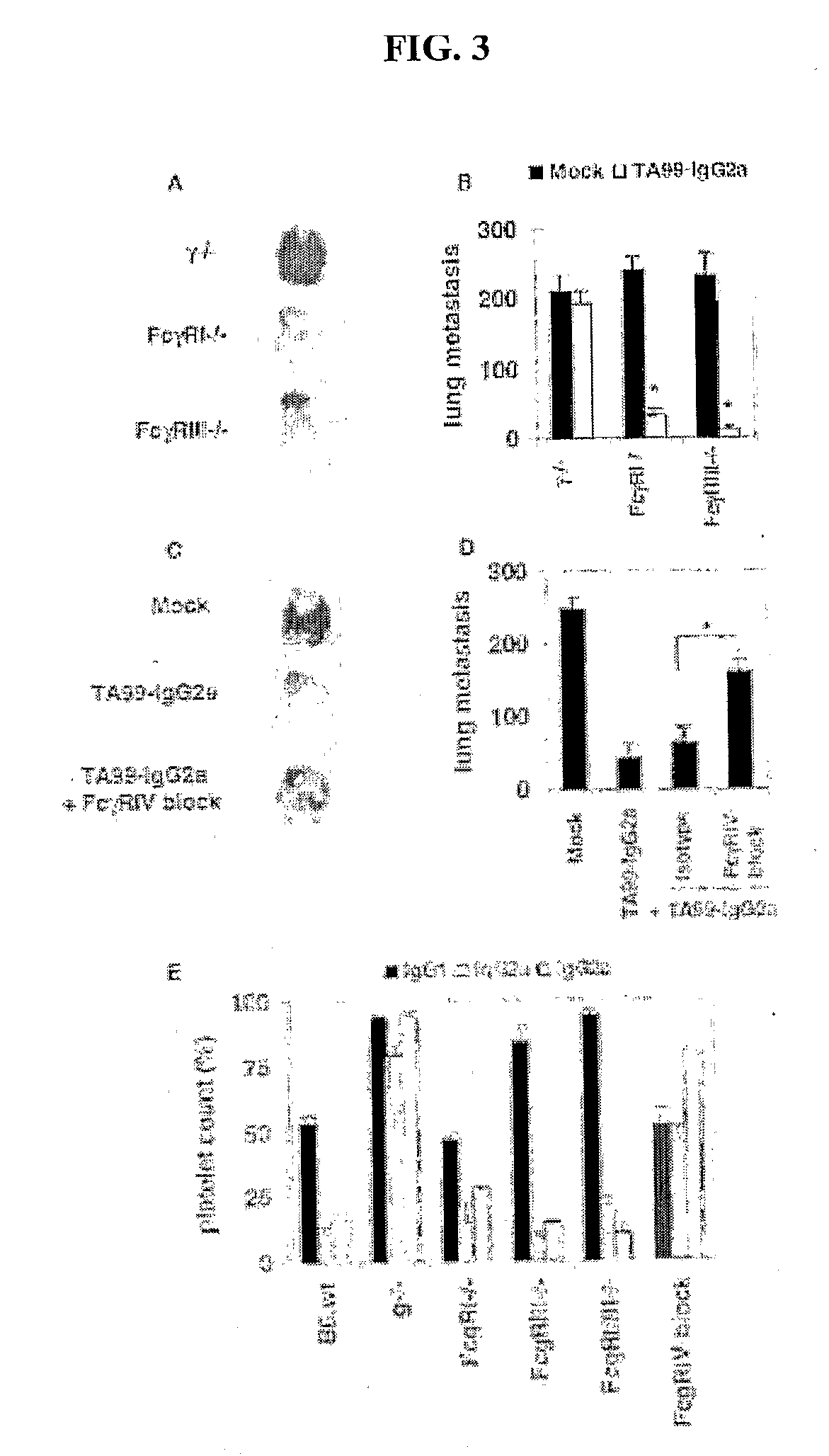Reagents, Methods and Systems for Selecting a Cytotoxic Antibody or Variant Thereof
a cytotoxic antibody and cytotoxic technology, applied in the field of cytotoxic antibody or variant thereof, can solve the problems of not providing a general method and no guidance for distinguishing among antibody variants, and achieve the effect of enhancing the effector function of therapeutic antibodies
- Summary
- Abstract
- Description
- Claims
- Application Information
AI Technical Summary
Benefits of technology
Problems solved by technology
Method used
Image
Examples
example 1
In Vivo Activity of IgG Subclasses Dependant on FcγR Specificity
[0090]To address the role of individual FcγRs to the in vivo activities of specific IgG subclasses a series of antibodies were constructed for two defined epitopes, in which the VH regions of the cloned hybridoma recognizing either the melanosome gp75 antigen (TA99 family) or anti-platelet integrin antigen (6A6 family) were grafted onto the C57BL / 6-derived G1, 2a, 2b or 3 constant regions and co-expressed with the appropriate light chains in 293 T cells (Nimmerjahn et al., Immunity 23, 41-51 (2005); Vijayasaradhi et al., J. Exp Med 171, 1375-80 (1990); and Clynes et al., Proc Natl Acad Sci USA 95, 652-6 (1998)). These recombinant antibodies were purified and tested for binding affinity to their cognate antigen (Table 1) and to soluble, recombinantly expressed FcγR I, II, III or IV by surface plasmon resonance or to transfected cells expressing a heterologous Fc receptor. Switching IgG constant regions did not affect the...
example 2
A / I Ratios of Antibody Variants Predictive if In Vivo Biological Activity
[0100]To determine how these differences in binding affinities relate to in vivo biological activity, the ability of these antibodies to mediate tumor clearance or platelet depletion was investigated. As seen in FIG. 1, both TA99 (FIGS. 1A and B) and 6A6 (FIGS. 1C and D) with IgG2a constant regions display enhanced tumor or platelet clearance, respectively, as compared to these antibodies with IgG1 constant regions. IgG2a and 2b are equivalent in their ability to mediate platelet clearance, while IgG2a results in enhanced tumor ADCC in the metastatic melanoma model as compared to IgG2b. The hierarchy of activity for the IgG subclasses is thus IgG2a≧IgG2b>IgG1>>IgG3. The mechanism of this differential activity was determined by repeating these experiments in specific activating FcγR or complement deficient strains. No differences in in vivo activity were observed for IgG1, 2a or 2b in complement deficient strain...
example 3
Modified Antibody with a Lower Amount of Fucose and a Greater A / I Ratio Compared to Unmodified Antibody
[0102]The relationship between the A / I ratio of IgG subclasses and in vivo activity was further tested using modified IgG constant regions. FcR binding to IgG is dependent on the presence of N-linked glycosylation at position 297; deglycosylation abrogates all FcR binding (Krapp, J Mol Biol 325, 979-89 (2003)). However, selective removal of specific carbohydrates, such as fucose, has been suggested to modify human IgG1 binding to human FcγRIII and thus to NK cell mediated ADCC in vitro (Shields, R. L., et al., J Biol Chem 277, 26733-40. (2002); T. Shinkawa et al., J Biol Chem 278, 3466-73 (2003); and Niwa et al., Cancer Res 64, 2127-33 (2004)). Fucose-deficient TA99-IgG1, 2a and 2b were prepared and their binding to FcγRI, II, III and IV was compared. Clq or antigen binding was not affected by the lack of fucose as described before (Shields (2002)). However, as shown in FIG. 5 and ...
PUM
| Property | Measurement | Unit |
|---|---|---|
| Fraction | aaaaa | aaaaa |
| Fraction | aaaaa | aaaaa |
| Volume | aaaaa | aaaaa |
Abstract
Description
Claims
Application Information
 Login to View More
Login to View More - R&D
- Intellectual Property
- Life Sciences
- Materials
- Tech Scout
- Unparalleled Data Quality
- Higher Quality Content
- 60% Fewer Hallucinations
Browse by: Latest US Patents, China's latest patents, Technical Efficacy Thesaurus, Application Domain, Technology Topic, Popular Technical Reports.
© 2025 PatSnap. All rights reserved.Legal|Privacy policy|Modern Slavery Act Transparency Statement|Sitemap|About US| Contact US: help@patsnap.com



